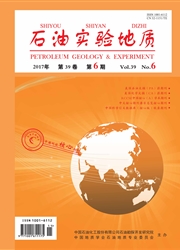

 中文摘要:
中文摘要:
根据轻烃、饱和烃、芳烃和碳同位素的系统分析资料,全面剖析了川东南地区官渡构造中侏罗统原油的地球化学特征,并通过油源对比确定了其主力烃源层。研究结果表明,该原油的C6-C8轻烃中以正构烷烃占优势,异构和环烷烃相对较少,几乎不含苯和甲苯,正庚烷明显高于甲基环已烷;其Pr/Ph值较低(1.56),C27-C29甾烷呈“V”字型分布,伽马蜡烷较高,表征油源岩为较深湖相沉积,成油母质生源构成中水生生物占有较高比例;正烷烃系列分布轮廓线呈上凸状,且碳同位素随碳数增加呈变轻趋势,具有一般陆相原油的特征;经轻烃、生物标志物参数对比,认为该原油与本区的上三叠统须家河组沥青和天然气没有成因上的联系,其油源来自下侏罗统烃源层。
 英文摘要:
英文摘要:
Based on the systematic analytical data of light hydrocarbon, saturate, aromatic fractions and carbon isotopes, the geochemical characteristics of Middle Jurassic oil from Guandu structure in the southeastern Sichuan Basin was investigated, and the source rock for the oil was determined by oil/ source rock correlation. The studied results reveal the oil shows a dominance of n-alkanes, low amount of branched/cyclic hydrocarbon and a lack of benzene and toluene with a predominance of heptane over methylcyclohexane in C5-C8 light hydrocarbons. Its relative low Pr/Ph (1.56), “V” shaped distribution of C27-C29 steranes and enhanced gammacerane indicate a profundal lacustrine source rock with relatively high contribution of aquatic organisms to deposited original organic matter The studied oil exhibits common features for a terrestrial oil, as reflected by its waxy n-alkane distribution and the isotope profile showing a trend toward isotopically light values with increasing n-alkane chain length. According to the correlations based on the parameters of light hydrocarbon and biomarkers, the oil is believed to be not in origin associated with the natural gas and asphalts in Xujiahe stratum (Upper Triassic), and is determined to be derived from Lower Jurassic source rock.
 同期刊论文项目
同期刊论文项目
 同项目期刊论文
同项目期刊论文
 期刊信息
期刊信息
